Guitar
Frets wear.
Eventually they wear out and need replacing.
If the wear is not too deep the frets can be ground down to the lowest point of the wear, re-crowned, polished and the guitar is ready for a few more years playing before re-fretting.
This is called fret dressing, fret stoning or fret leveling - same thing.
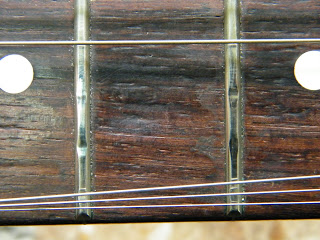
One of the most important points to remember is the frets need to be level, if one is higher or lower than the rest there will be buzz in that area.
I cannot stress enough how important this is - you need the right tools and preferably plenty of experience to do this job well.
I'm not writing a 'how to' guide here, just showing what I do for those who are interested. I use this blog primarily to help explain to players what needs to be done to their instrument and keep my replies to email inquiries short.
This nice old '84 Strat came to me for a set up.

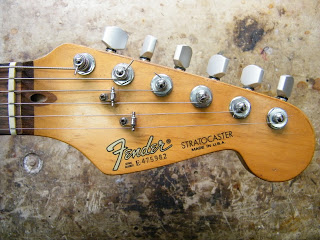
I always discuss the guitar with the player when he/she is in the workshop. It is so much easier to understand the problem and hear what they are hearing when we're together with the instrument.
This is why I don't do work for guitar shops, I don't feel I can do my job properly if I can't communicate with the player.
I get to meet a lot of interesting characters that way too.
A lot of the notes sounded 'dead' especially on the first 3 strings and I could see there was a lot of fret wear.
The strings were sitting in large grooves and buzzing on the fret in front. These grooves were flat on the bottom giving the string an undefined area to vibrate off. With a well crowned, rounded fret the string has a positive 'point' to vibrate off and 'sings'.
This guitar being a Fender I'm able to unbolt the neck. It makes the job a little easier if I attach it to a dummy body.
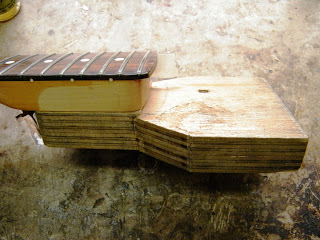
I mask off the fretboard to avoid any stray file scratches and to prevent the board getting gooed up with buffing soap later on.
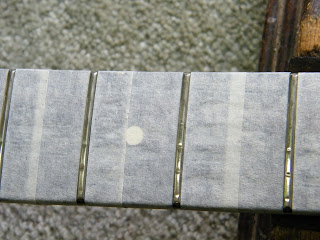
On some maple (therefore lacquered) boards I'll use a low tack masking tape. A lot of 90's Fenders have problems with lacquer peeling off their necks and I don't want to pull any of the finish off when I remove the tape.
I use a marker pen on the frets so I can see the high and low spots .
To do the leveling work I use a box section steel bar. One face has been machined flat using some pretty sophisticated machinery by an engineering company.
I don't trust files to be flat and only use them for roughing off large amounts of fret if the wear is really bad.
I use a thin double sided tape to attach 320grit wet or dry paper to my leveling block. The 320 scratches can be easily taken out later with finer grades before buffing.
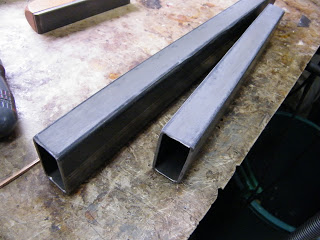
I support the neck along its length to prevent any bending and grind the frets evenly to take the wear out. Most necks need some truss rod adjusting to minimize the amount of work needed.
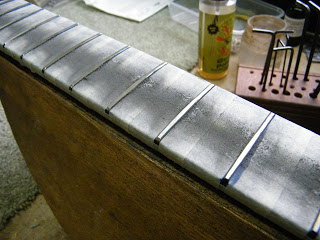
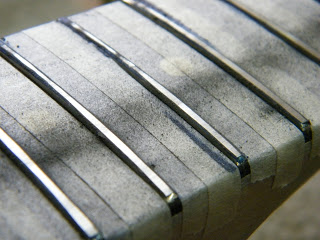
I want to keep the neck straight between frets 1 and 12, remove the wear and have the upper frets falling away slightly.
This is where the experience comes in.
All necks are different so its not easy to explain - a certain amount of 'feel' is required. I'm trying to take the minimum of 'meat' off them but still getting rid of the wear.
When I'm happy with the stoning I need to crown. I mark the frets again with the marker pen and use a metal fretboard guard to protect the board from the file.
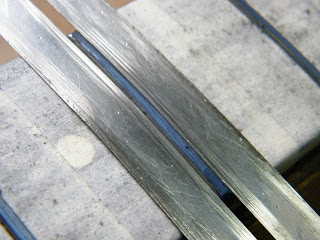
I use a triangular fine cut file from www.stewmac.com.

I need to take material from the sides of the fret without touching the top of the crown - a stray file stroke and one fret will be lower than the others. The marker pen helps me see how far I have left to go.
This takes time.
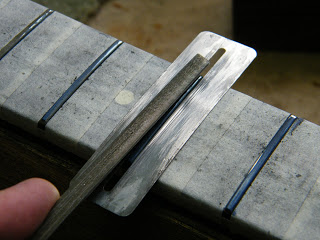
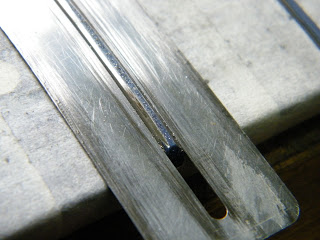
Once the crowning is done I need to polish the frets up. I sand them with wet and dry paper being very careful to give each fret an even number of strokes with the paper. I go through 320, 400, 600 and 800 grades.
For the final polishing I use the buffing wheel.

It saves a lot of time and gives a great finish. A well crowned, shiny fret is a joy to play on - string bending and vibrato are effortless.
Then I carefully remove the masking tape, clean the fretboard (I prefer lighter fluid for this) and oil it.
The guitar is now ready to be set up. I've written about setting up before:
http://mrglyn.blogspot.com/2009/06/set-up.html
This guitar happens to be a Strat but the same procedure applies to all fretted instruments. If you play it - the frets will wear.
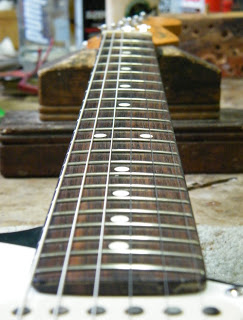
Just a word of caution- if you don't have the right tools, not sure what you're doing or have no experience with guitar repair you can make quite a mess trying this at home.
I see quite a lot of roughly filed frets and scratched and dented fretboards - just thought I'd mention it :-)
Cheers
Glyn
………………………………………………………………………………………….
Feel free to contact me about repair work (if you are in NZ). I only check emails weekly so the workshop phone is always the best 09 307 6501.
- Les Paul '79 - Refret With A Difference
A customer recently brought me a Les Paul Custom from 1979. He's owned the guitar a long time but in the last few years it's been relegated to the case. He wanted to be playing it again so brought it to me to get it back into playing...
- Stainless Steel Fretwire
I get often asked 'what's the difference between normal frets and stainless steel?'. I first used stainless steel fretwire in '08 when a customer requested it and now offer it as an option when re-fretting. For most players new frets...
- A Look At A Pro's Guitar
This time I'm looking over a Pro guitarist's highly modified Stratocaster and his set up preferences. Warren Mendonsa (http://en.wikipedia.org/wiki/Blackstratblues) is known as a Strat player though he is certainly not a traditionalist. He...
- Scalloping A Fingerboard
I have customers who play all styles of music and this one is most definately ROCK. It can be such a treat having great musicians playing in the workshop, just showing me what's wrong with their guitars or trying them out after I've worked on...
- Maton 'phil Manning' Re-fret
I get a lot of enquiries about re-fretting - what's involved, how does it affect the guitar's sound and playability? So when this rather nice old Maton came in for a re fret I took the chance to take a few photos. This is not too good a picture...
Guitar
Fret Stone - Fender Stratocaster
Frets wear.
Eventually they wear out and need replacing.
If the wear is not too deep the frets can be ground down to the lowest point of the wear, re-crowned, polished and the guitar is ready for a few more years playing before re-fretting.
This is called fret dressing, fret stoning or fret leveling - same thing.

One of the most important points to remember is the frets need to be level, if one is higher or lower than the rest there will be buzz in that area.
I cannot stress enough how important this is - you need the right tools and preferably plenty of experience to do this job well.
I'm not writing a 'how to' guide here, just showing what I do for those who are interested. I use this blog primarily to help explain to players what needs to be done to their instrument and keep my replies to email inquiries short.
This nice old '84 Strat came to me for a set up.


I always discuss the guitar with the player when he/she is in the workshop. It is so much easier to understand the problem and hear what they are hearing when we're together with the instrument.
This is why I don't do work for guitar shops, I don't feel I can do my job properly if I can't communicate with the player.
I get to meet a lot of interesting characters that way too.
A lot of the notes sounded 'dead' especially on the first 3 strings and I could see there was a lot of fret wear.
The strings were sitting in large grooves and buzzing on the fret in front. These grooves were flat on the bottom giving the string an undefined area to vibrate off. With a well crowned, rounded fret the string has a positive 'point' to vibrate off and 'sings'.
This guitar being a Fender I'm able to unbolt the neck. It makes the job a little easier if I attach it to a dummy body.

I mask off the fretboard to avoid any stray file scratches and to prevent the board getting gooed up with buffing soap later on.

On some maple (therefore lacquered) boards I'll use a low tack masking tape. A lot of 90's Fenders have problems with lacquer peeling off their necks and I don't want to pull any of the finish off when I remove the tape.
I use a marker pen on the frets so I can see the high and low spots .
To do the leveling work I use a box section steel bar. One face has been machined flat using some pretty sophisticated machinery by an engineering company.
I don't trust files to be flat and only use them for roughing off large amounts of fret if the wear is really bad.
I use a thin double sided tape to attach 320grit wet or dry paper to my leveling block. The 320 scratches can be easily taken out later with finer grades before buffing.

I support the neck along its length to prevent any bending and grind the frets evenly to take the wear out. Most necks need some truss rod adjusting to minimize the amount of work needed.


I want to keep the neck straight between frets 1 and 12, remove the wear and have the upper frets falling away slightly.
This is where the experience comes in.
All necks are different so its not easy to explain - a certain amount of 'feel' is required. I'm trying to take the minimum of 'meat' off them but still getting rid of the wear.
When I'm happy with the stoning I need to crown. I mark the frets again with the marker pen and use a metal fretboard guard to protect the board from the file.

I use a triangular fine cut file from www.stewmac.com.

I need to take material from the sides of the fret without touching the top of the crown - a stray file stroke and one fret will be lower than the others. The marker pen helps me see how far I have left to go.
This takes time.


Once the crowning is done I need to polish the frets up. I sand them with wet and dry paper being very careful to give each fret an even number of strokes with the paper. I go through 320, 400, 600 and 800 grades.
For the final polishing I use the buffing wheel.

It saves a lot of time and gives a great finish. A well crowned, shiny fret is a joy to play on - string bending and vibrato are effortless.
Then I carefully remove the masking tape, clean the fretboard (I prefer lighter fluid for this) and oil it.
The guitar is now ready to be set up. I've written about setting up before:
http://mrglyn.blogspot.com/2009/06/set-up.html
This guitar happens to be a Strat but the same procedure applies to all fretted instruments. If you play it - the frets will wear.
Just a word of caution- if you don't have the right tools, not sure what you're doing or have no experience with guitar repair you can make quite a mess trying this at home.
I see quite a lot of roughly filed frets and scratched and dented fretboards - just thought I'd mention it :-)
Cheers
Glyn
………………………………………………………………………………………….
Feel free to contact me about repair work (if you are in NZ). I only check emails weekly so the workshop phone is always the best 09 307 6501.
Workshop Hours
Mon……. 8-6
Tues……. 8-6
Wed…….. Closed
Thurs …..8-6
Fri ……….8-6
Sat/Sun ..Closed
Tues……. 8-6
Wed…….. Closed
Thurs …..8-6
Fri ……….8-6
Sat/Sun ..Closed
Mr Glyn’s Guitars
21a Khyber Pass Road
Auckland
New Zealand
http://www.mrglyn.co.nz/
www.facebook.com/MrGlynGuitars
www.mrglyn.blogspot.com
09 307 6501, 021 912678
- Les Paul '79 - Refret With A Difference
A customer recently brought me a Les Paul Custom from 1979. He's owned the guitar a long time but in the last few years it's been relegated to the case. He wanted to be playing it again so brought it to me to get it back into playing...
- Stainless Steel Fretwire
I get often asked 'what's the difference between normal frets and stainless steel?'. I first used stainless steel fretwire in '08 when a customer requested it and now offer it as an option when re-fretting. For most players new frets...
- A Look At A Pro's Guitar
This time I'm looking over a Pro guitarist's highly modified Stratocaster and his set up preferences. Warren Mendonsa (http://en.wikipedia.org/wiki/Blackstratblues) is known as a Strat player though he is certainly not a traditionalist. He...
- Scalloping A Fingerboard
I have customers who play all styles of music and this one is most definately ROCK. It can be such a treat having great musicians playing in the workshop, just showing me what's wrong with their guitars or trying them out after I've worked on...
- Maton 'phil Manning' Re-fret
I get a lot of enquiries about re-fretting - what's involved, how does it affect the guitar's sound and playability? So when this rather nice old Maton came in for a re fret I took the chance to take a few photos. This is not too good a picture...
